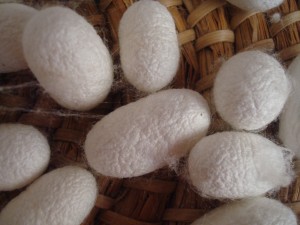Silk Winding
Silk origins from the silkworm, the larva of the silkmoth, a rather unspectacular looking kind of moths. The fibre-material is made by the worm when it spins it’s cocoon which is about 35 mm long and 20-25 mm in diameter. The outer and inner parts of the cocoon consist of a loose, see through material which is not of a good quality. The very inside of the cocoon is made of a parchment-like shell for the worm.
One cocoon can offer up to 1 km of silk fibre, but only about 300-600 m can be (and have in medieval times been) used for high quality silk products.
Since the moths destroy the cocoon when hatching and with it the long silk fibre, the worm has to be killed before the cocoon is being unwinded. This is mostly done by cooking the cocoons in hot water/lye or steam. More animal friendly is freezing the worms.
For unwinding the cocoons one needs 4 things: a pot of hot water/lye in which the cocoons can be soaked, a brush to eliminate the bad quality silk, a loop through which the silk strings can be bundeled and a winder/decoiler for unwinding. Since the fibres are covered in silk glue, the single strands stick together when being bundeled and make a strong string, event without being twisted.
The winded silk is known as “raw silk”, “grège” or “grez” and has to be twisted (silk twist, mulinated silk). It is used for waving, embroidery and sewing. The silk that is unwinded from the cocoon is matte and not yet shining due to the silk glue, through cooking the silk in a 90 degrees celsius hot lye. This also makes them dyeable easier.






